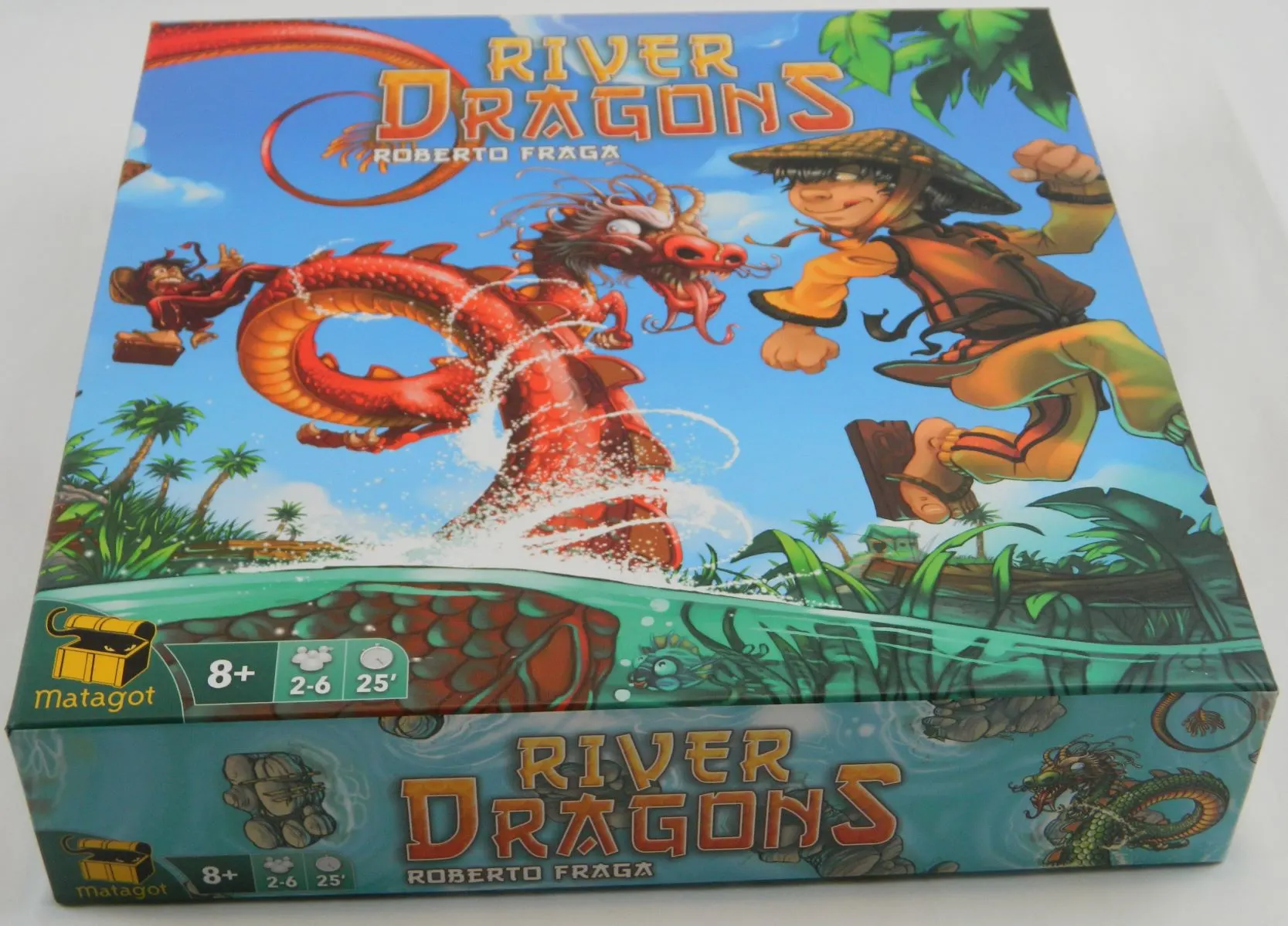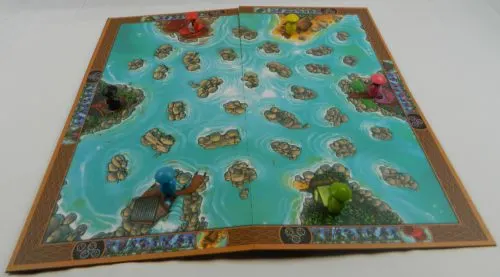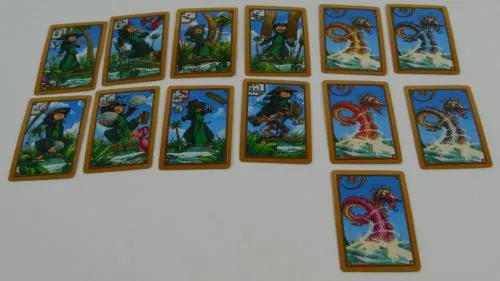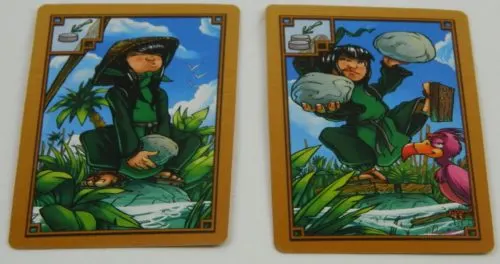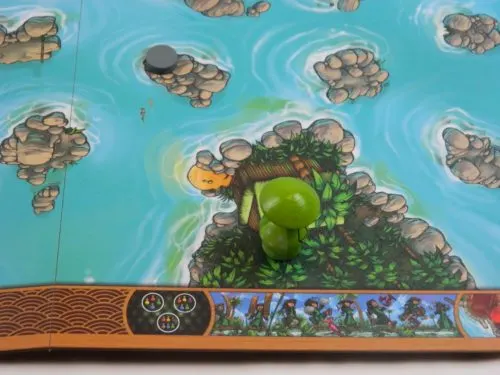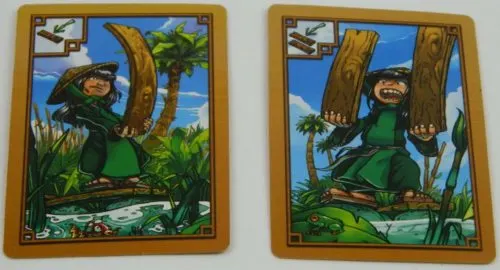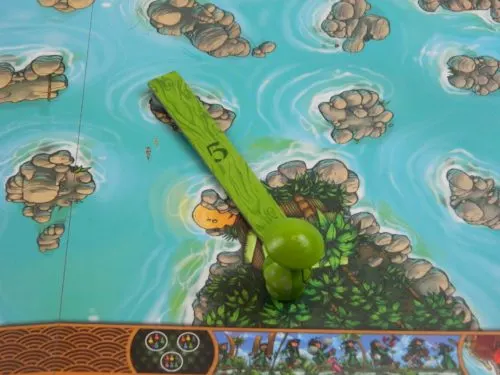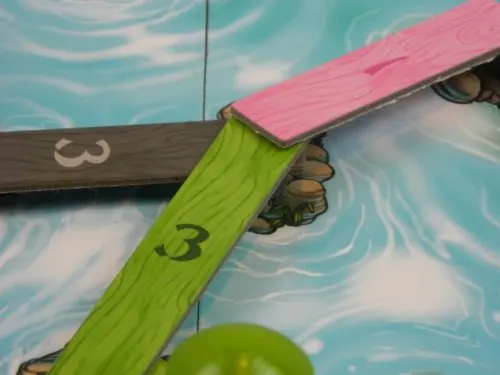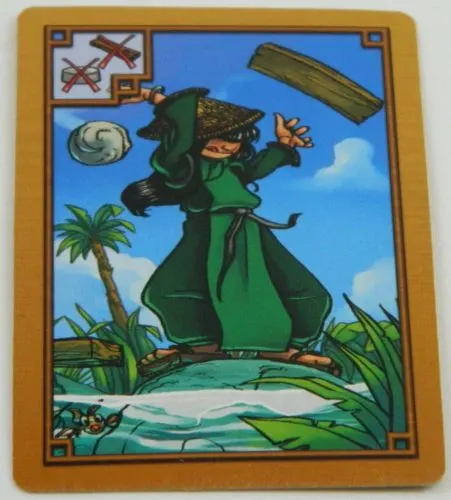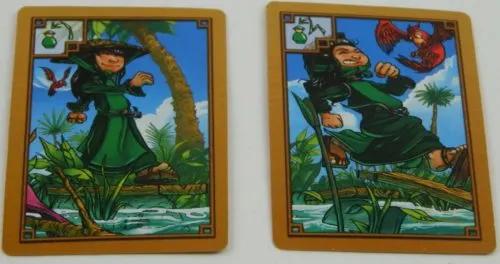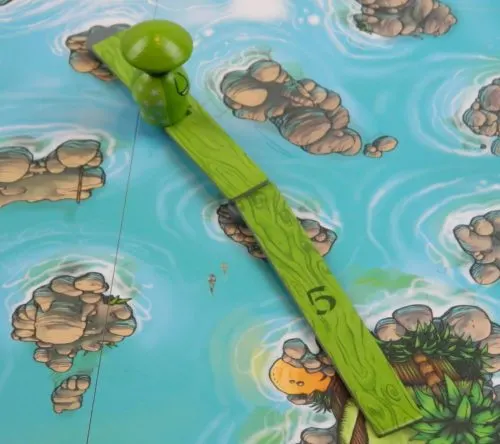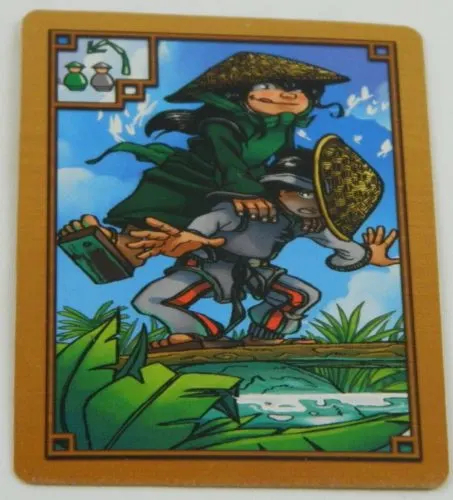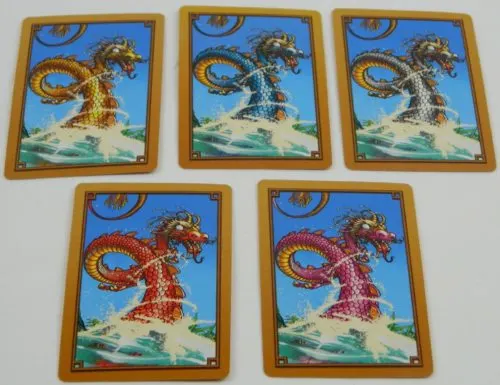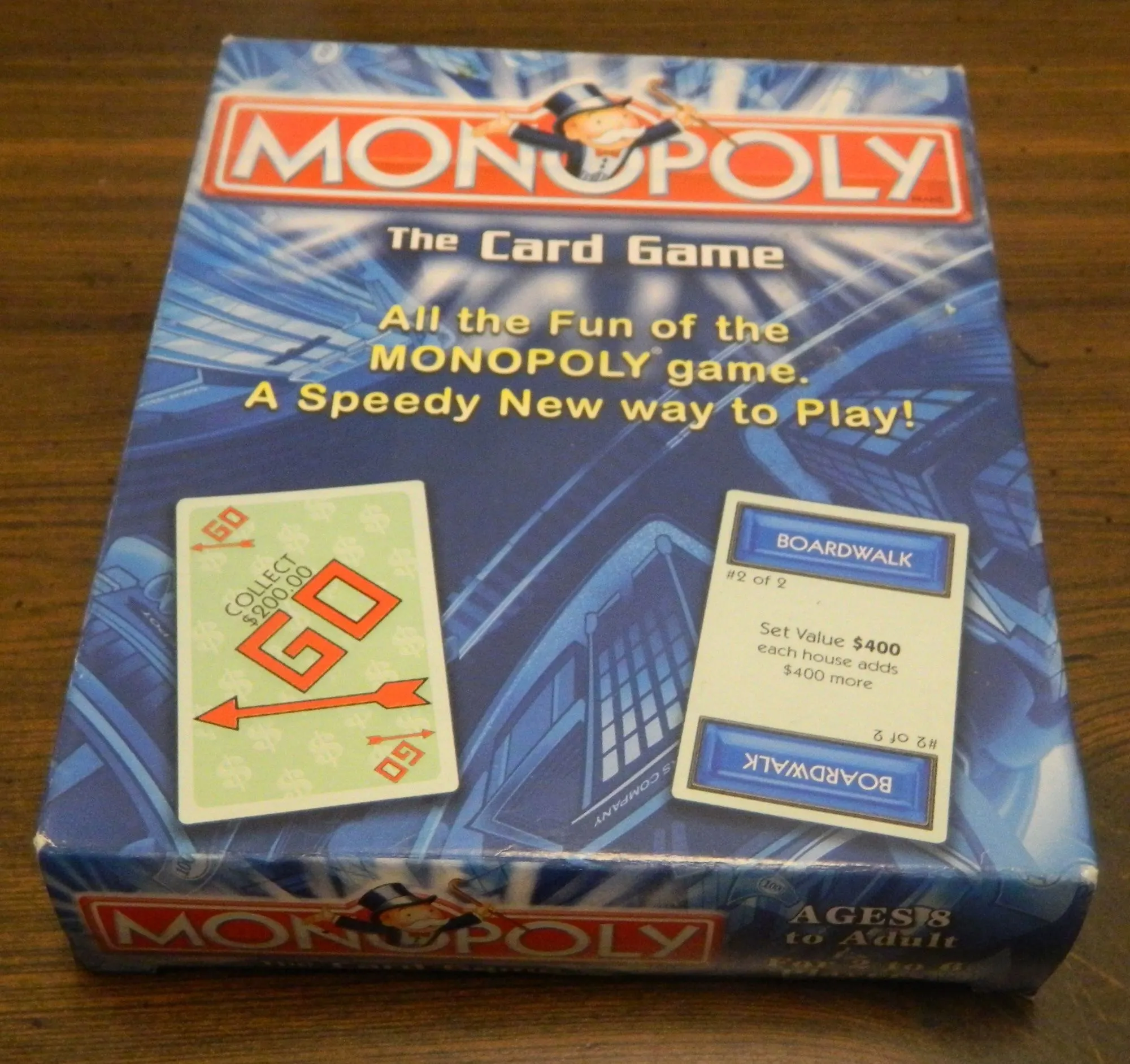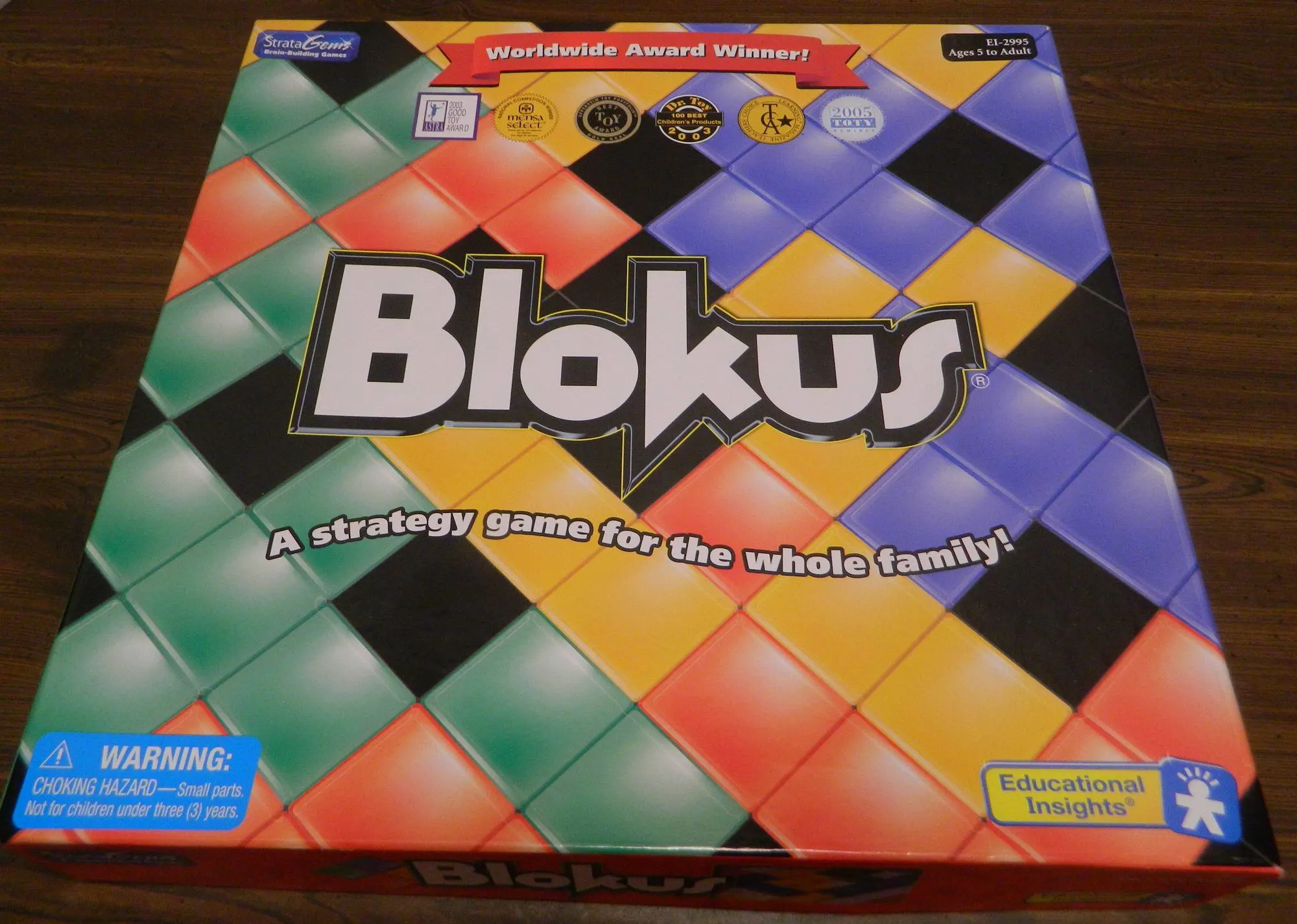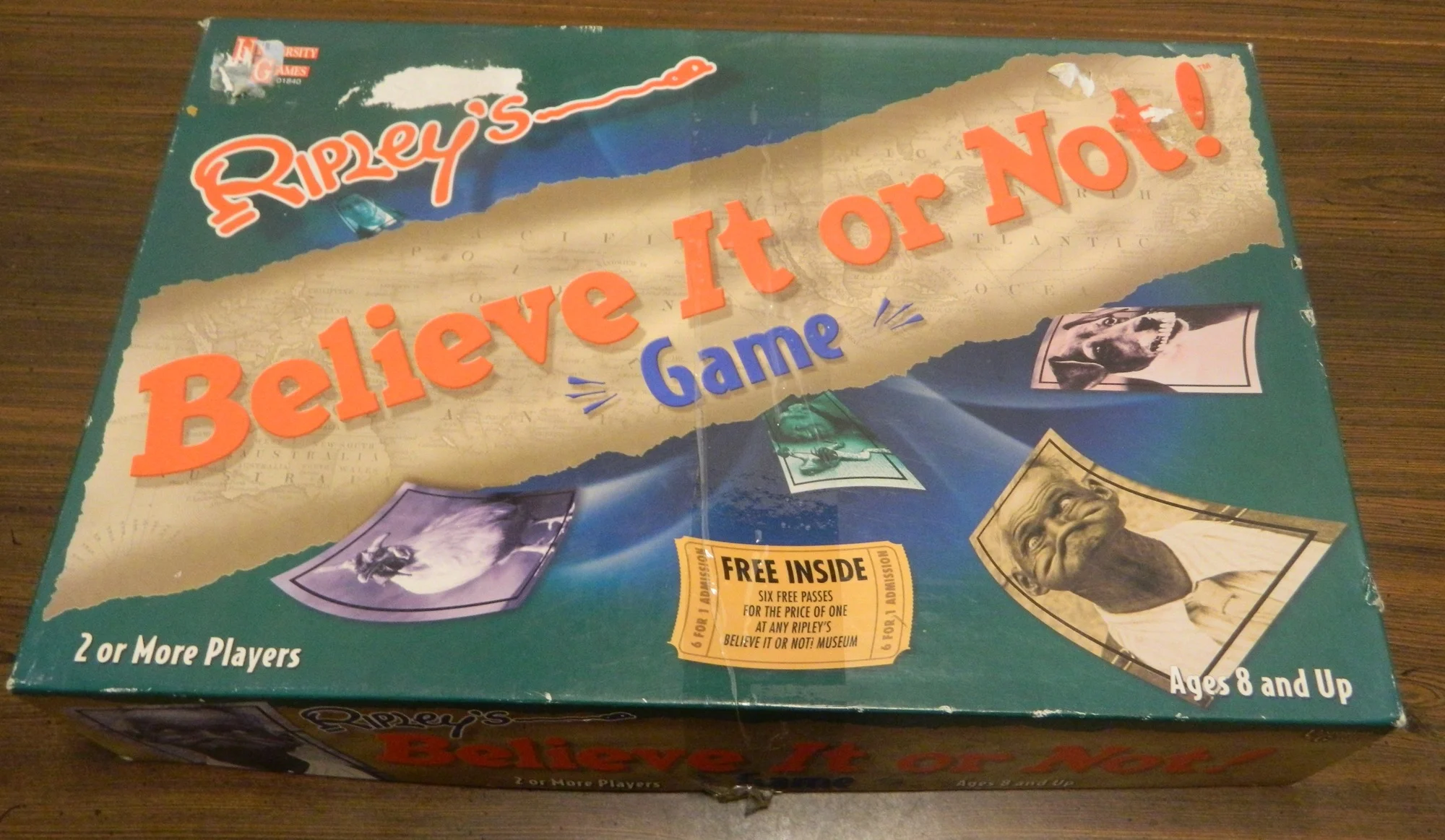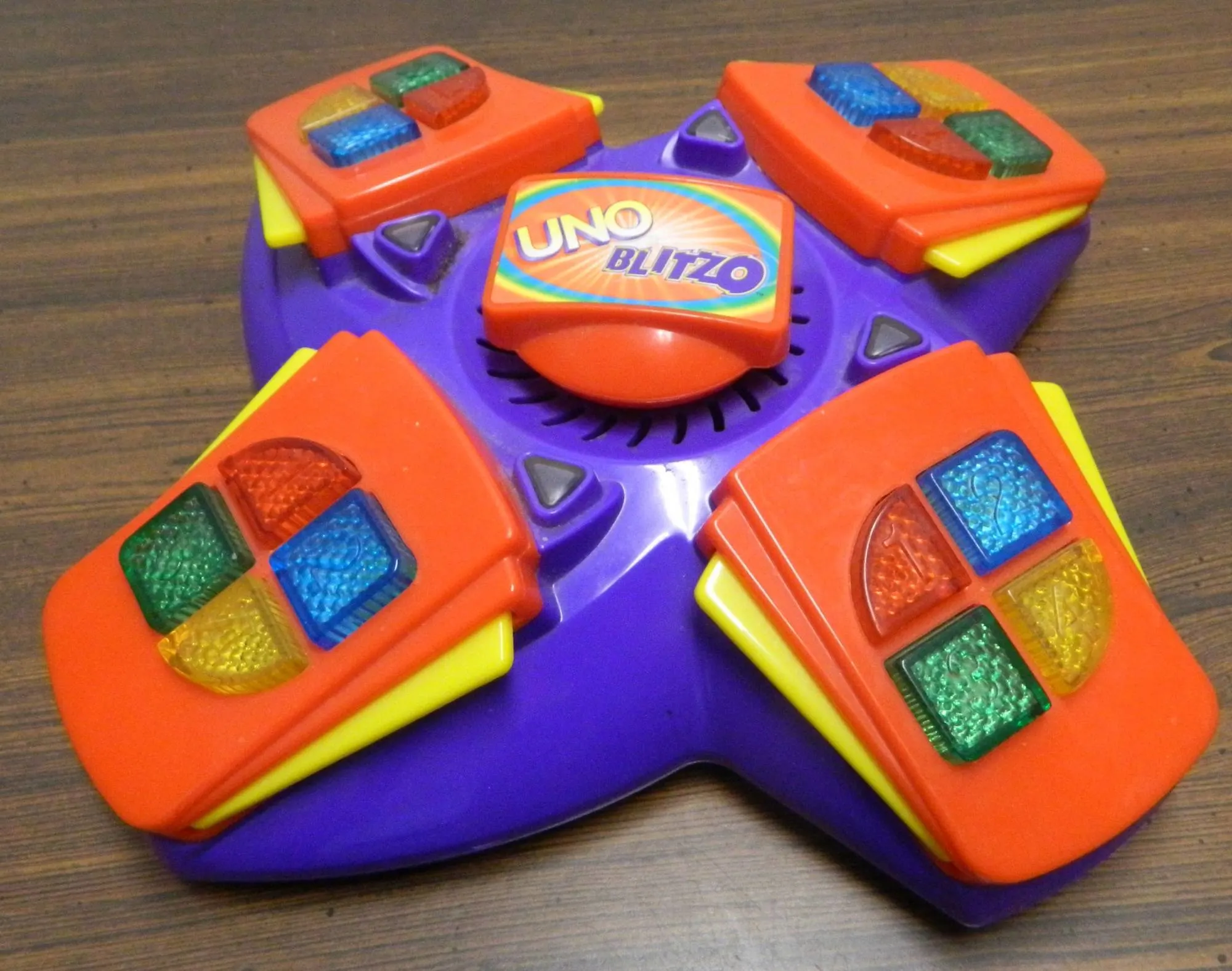Over the years I have taken a look at a number of games created by Roberto Fraga which includes Dr. Beaker, Dr. Eureka, Dr. Microbe, and Ka-Boom. While most of his games tend to be gauged more towards a children/family audience, I have enjoyed all of his games that I have played so far. Today I am actually looking at the first game designed by Roberto Fraga, River Dragons (originally named Dragon Delta). In addition to being one of his most popular games, I was intrigued by the game’s premise as you try to create a path of planks to the other side of the board. River Dragons can be a little too cutthroat at times, but the game deserves credit for an original idea that the whole family can enjoy.
How to Play River Dragons
Setup
- Place the board in the middle of the table with the side showing the islands face up. The other side is used for the expert game.
- Place the stones in a pile next to the gameboard where everyone can reach them.
- Pick a color that corresponds to one of the starting villages. The colors you can pick from depends on the number of players.
- 2 players – pink, and black
- 3 players – blue, red, and pink
- 4 players – blue, green, red, and yellow
- 5 players – all of the colors besides pink
- 6 players – all of the colors
- Each player will take the following components:
- Pawn of chosen color
- 6 planks of chosen color
- 13 action cards of the chosen color. The dragon cards of the colors not used by a player are returned to the box.
- The youngest player will take the first player card and places it in front of them. They will be the first player in the first round. The role will pass clockwise each turn.
Playing the Game
Each turn consists of two phases.
- Programming Phase
- Resolution Phase
The objective of the game is to get your pawn to its destination village on the opposite side of the board.
Programming Phase
In the programming phase each of the players will chose five of the cards from their hand that they would like to play during the current turn. They will place these cards face down in front of themselves. The order (from left to right) that the cards are placed matters as the cards will be revealed and resolved in the order that they were placed. Once you place cards they cannot be exchanged or moved.
Resolution Phase
Once all of the players have chosen their cards, the resolution phase begins.
All of the players will reveal their first card. Starting with the first player and moving clockwise, each player will resolve the card that they played.

For their first card this player played a two stones card. They will get to place two stones on the game board.
After all of the first cards are resolved, players will reveal and resolve their second cards. This continues until all five cards have been revealed and resolved.
Cleanup
Before starting the next turn some cleanup will be performed.
The first player will pass the first player card to the player on their left. This player will be the start player for the next turn.
All of the players will take the cards that they played back into their hands. Thus players can end up playing the same cards multiple turns in a row.
Cards
Most of the gameplay is driven by the cards that players decide to play. Each of these cards have a special impact on the game.
Placing Stones
There is a place one stone card and a place two stone card. The only difference between these two cards are the number of stones you will place.
When placing a stone you will take one of the stones from the supply to the side of the gameboard. If there are no stones available, you forfeit the action. A stone can be placed on any island (not villages) that does not already have a stone on it. The stones can be placed on any part of the island, but once they are placed they cannot be readjusted.
Placing Planks
There are two different cards that allow you to place planks onto the gameboard. One of the cards allows a player to place one plank, while the other forces the player to place two planks.
A player will chose one/two of the planks from their supply to add to the gameboard. Once a player chooses a plank they must place it. To place a plank a player has to place it between two stones or a village and a stone. If a chosen plank is longer than the distance between two stones/village, the plank can still be placed.
If the plank is too short that it touches the board, it must be placed somewhere else.
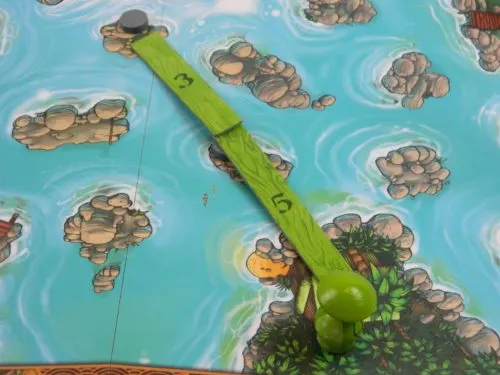
This player tried to place their three plank. The plank was too short to reach the stone they wanted to place it on. They will either have to find somewhere else to place it, or they will lose it for the rest of the game.
Some rules when placing planks include:
- You can never move the position of a stone in order to place a plank.
- A plank cannot rest on another plank unless both are supported by a stone.
- A stone/village can only support three planks at a time.
If a player can’t find a place to put their chosen plank, it is removed from the game.
Removing Planks and Stones
One of the cards allows a player to either remove a plank or a stone from the gameboard.
Some rules regarding removing planks are as follows:
- When removing a plank it will be added to the player who played the card’s plank reserve so they can use it on a future turn.
- You cannot remove a plank that has a pawn on it.
- You cannot have two planks in your reserve of the same size
- You cannot have more than two different colors of planks in your reserve.
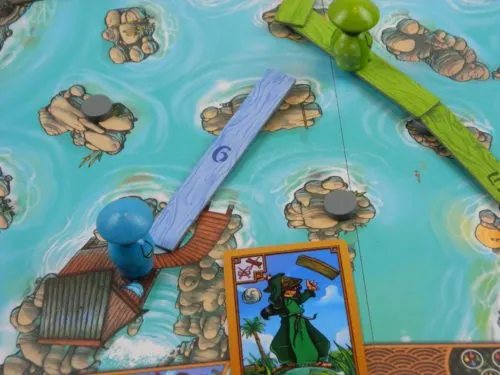
The green player played their remove plank/stone card. They have decided to remove the plank in front the blue player before they are able to move onto it.
As for removing stones, you can never remove a stone that has one or more planks on it.
If there are no planks or stones that the player can remove, they will lose their action.
Movement
There are two cards that allow a player to move their pawn. One card allows a player to move their pawn one space, and the other card allows a player to move their pawn two spaces. Moving to an adjacent plank or village counts as one movement. Some rules that must be followed while moving include:
- A player can never move to a plank that is occupied by another player. Any number of players can be in the same village though.
- When you chose a movement card you must move the full length of the card you play. For example if you play the two movement card, you must move two spaces.
- You can move in any direction, and onto planks of any color.
- If you chose the two movement card, you may move in one direction and then move back to the original plank for your second movement.
If a player is unable to use all of their movement, their pawn will fall into the water. Their pawn will then be moved back to their starting village.
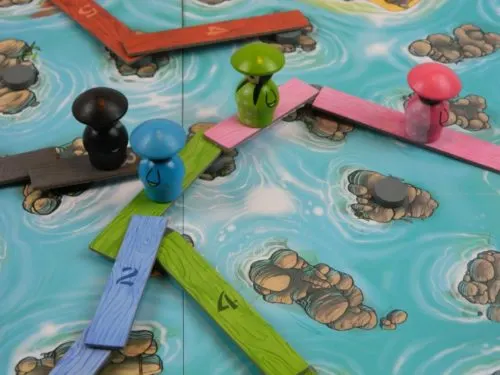
The green player played a movement card. As they have nowhere to move, they will fall into the river and be set back to their start space.
Jumping Over Other Players
When a player plays this card they will jump over another player’s pawn (that is on an adjacent plank) onto a plank/village adjacent to the other player.
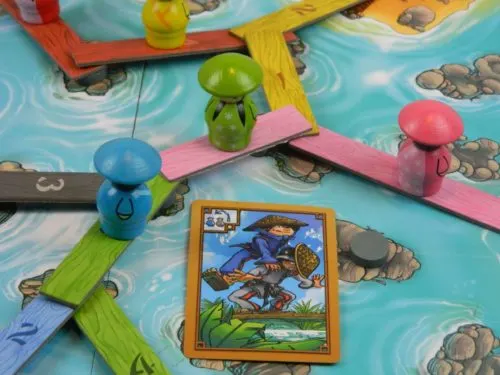
The blue player played a leap card. By playing the card they will be able to jump over the green player onto the yellow one plank.
If the player is unable to make the jump, they will fall into the water. They will return their pawn to their starting village.
River Dragons
Each player will have a river dragon card for the color of every other player. When a player plays one of these cards they will cancel the card played by another player at the same time. For example if a player plays a red dragon card for their third card, the red player’s third card will be nullified.
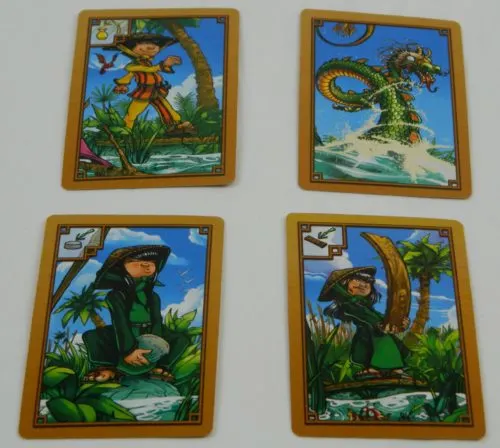
For their second card the top player played a green dragon card. The green dragon will cancel out the plank card played by the green player.
A dragon card does not cancel the effect of another dragon card though. So if a player whose card was nullified ended up playing a dragon card themselves, both dragon cards would apply.
Players are only allowed to play one Dragon card each turn.
End of Game
The game ends immediately once a player’s pawn reaches its destination island. This player will win the game.
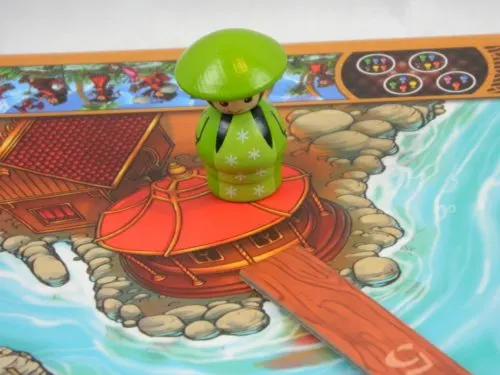
The green player has reached the village on the other side of the board. The green player has won the game.
My Thoughts on River Dragons
I honestly have to say that I am not entirely sure how I would describe River Dragons. This is partially because the game is not really like any other games that I have played. In a lot of ways it feels like a combination of a number of different genres and mechanics. Because of this, I think the best way to review the game is to look at each of these mechanics individually.
I would probably say that River Dragons main mechanic is probably the programming mechanic. For those of you who have never played a movement programming game before, the basic premise is that players have to commit to their actions for the upcoming turn before they know what the other players chose to do. All of the players are given the same cards which correspond to the different actions that they can take. Players will choose the five actions that they would like to take, and they will place them in the order that they would like to take them. This locks players into their chosen actions as they can’t change the order of their cards after they play them.
I haven’t played a lot of programming games in the past, but I like the idea behind them. As players have to commit to their choice before knowing what the other players are going to do, you need to plan ahead. You need to create a plan for what you want to achieve and then choose the order of the cards that you think will achieve that task. Other players are playing at the same time as you though so you need to keep that in mind as well. You need to build contingencies into your plan as one player can play a card that could otherwise ruin your strategy. I generally enjoyed this aspect of the game as there is a decent amount of strategy behind choosing what cards to play. The real key to doing well in the game is being able to read the other players as the cards they play can have as big of an impact on your fate as the cards you play yourself.
The one drawback to the programming mechanic is that it adds a pretty significant take that element to the game. While you need to keep in mind what the other players might do when coming up with your plan, other players’ actions can really mess with you. First players can play a dragon card that nullifies one of your actions. Players could also remove a plank or stone that you need, or even move their own pawn to block you. Depending on how you played your cards, players messing with just one step of your plan could ruin the rest of your turn. You can mitigate this some by putting in some contingencies and altering your plan, but you can’t deal with all of these situations. At times it feels like luck has to be on your side for you to succeed.
This can be pretty frustrating as players could easily gang up on one of the players if they wanted to. This can especially happen when one of the players gets close to winning the game. Some players are going to love this aspect of the game as they like to mess with the other players. Other people will be turned off by it as the game is by its nature pretty confrontational. In order to win the game you pretty much have to mess with the other players.
The other major mechanic in River Dragons involves placing the planks in order to create a path to the other side of the board. I don’t know exactly how to describe this mechanic as I can’t recall playing another game with a similar mechanic. Much of this mechanic deals with spatial awareness. You basically have to make estimates of distances when placing stones and planks onto the board. As you are never allowed to measure distances, you have to use your ability to visualize the board and planks in your head. You want to place stones further apart in order to shorten your distance to the other side of the board. You don’t want to make the distance too far though where you choose a plank that doesn’t reach across the gap.
I found this mechanic to be really interesting. There is a sort of risk/reward element built into the mechanic. You want to place your stones further apart as it allows you to move across the board quicker. There is a risk in this though as you could end up creating too large of a gap where you don’t have a plank that will bridge the gap. This will force you to either lose one of your planks or place it somewhere that you otherwise wouldn’t have wanted to place it. This could also mess up your plan as you might not be able to create the path that you originally planned. The key to doing well with this mechanic is being able to look at the board and compare distances to the planks that you still have available. This mechanic is pretty fun and unique, as I can’t think of another game that utilizes a similar mechanic.
The only real problem that I have with the mechanic is that it is not always that easy to place the planks. When placing a plank you need to be careful not to move a stone placed on the board or another plank. This becomes quite a bit harder when someone chooses the action that allows them to remove a plank. When a player removes a plank from a stone that has several planks on it, other planks will regularly fall off and the stone’s position might slightly change. For this reason you need to be really careful when adding and removing planks, or you need to try and move things back to where they were originally if something should happen.
For the most part I would say that River Dragons is pretty easy to play. The game has a recommended age of 8+ which seems about right. The game uses symbols and pictures instead of words which allows players to not have to worry about having to read text. I see no reason why children should have any trouble with the game’s rules. They might play kind of randomly and not really understand the strategy. Honestly the most challenging part about the game is remembering what all of the different cards do. This has a little learning curve, but it is pretty easy once you get used to it. Outside of the gameplay being a little unorthodox, I see no reason why someone who rarely plays board games couldn’t enjoy River Dragons.
I was a little more conflicted about the game’s length. I really see River Dragons being the type of game that could either end really quickly or take forever. This really depends on what type of players are playing the game. If players are more aggressive with trying to mess with one another the game is going to take considerably longer, as players’ plans will be ruined. If players aren’t too confrontational though the game seems to end too quickly. If you don’t play defensive and try to mess with other players, they could easily reach their target village within just a couple of turns. As the people that I played with aren’t the most confrontational, the game did seem to end kind of quickly.
As for the components I thought River Dragons mostly did a good job. For this review I used the 2016 edition. I thought the game’s pawns were cute. The pawns are made of wood and are larger than I would have thought. I thought the artwork was nice and works well with the game’s theme. The cards and cardboard pieces are made of a thick enough cardboard that they should last. I kind of wish the game included some more movement cards, but this isn’t a big problem. The main complaint that I had with the components was that some of the planks were hard to punch out which lead to some issues around the edges. I am not sure if this was just an issue with the new copy I purchased, or if it is a more common problem. This is just a cosmetic issue though, and doesn’t actually impact the gameplay.
Should You Buy River Dragons?
I have played a lot of different board games, and yet I don’t remember playing one quite like River Dragons. The game doesn’t really fit into a traditional board game genre as it feels more like a combination of different mechanics. At its core the game is a movement programming game as players choose their actions before they know what the other players chose to do. I thought this was a fun mechanic requiring quite a bit of planning and trying to read the other players. Players can really mess with one another though which can be kind of frustrating. Otherwise much of the game is about trying to estimate distances so you can place planks successfully while reducing the number of planks that you have to move through. This mechanic is also pretty fun even though you have to be really careful when adding and removing planks. River Dragons is pretty easy to play, but the length can vary quite a bit depending on how much the players mess with one another.
My recommendation for River Dragons mostly comes down to your feelings towards the premise. If the game doesn’t sound all that interesting, I don’t think it will be for you. Those that think the premise sounds interesting though and don’t mind the take that mechanics, should enjoy River Dragons and consider picking it up.
Buy River Dragons online: Amazon(River Dragons, Dragon Delta
), eBay (River Dragons
, Dragon Delta
). Any purchases made through these links (including other products) help keep Geeky Hobbies running. Thank you for your support.

